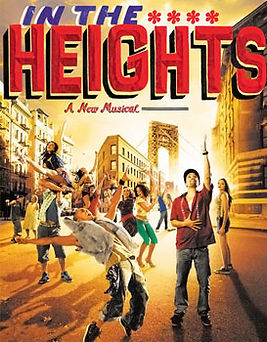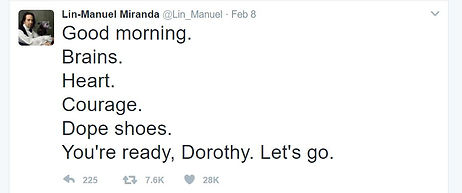

Lin Manuel Miranda's Artifacts
Lin Manuel Miranda is a modern pop culture icon who became quite popular following the release of his hit musical, Hamilton. As an icon, he has obtained a large fan base through the musical which he composed and acted in, as well as through his Twitter account. This has been effective in making him an admirable icon.
The Hamilton musical is an important reflection on who Lin Manuel Miranda is as a person. In CBS’s 60 Minutes with Charlie Rose, Miranda discussed, “a direct line between Hamilton's writing his way out of his circumstances and the rappers [he]'d grown up adoring,” (Rose) which is how he could write the musical. Miranda identifies with Hamilton’s story, “[Miranda’s] father moved from Puerto Rico when he was 18,” (Rose). What makes Miranda so influential as a pop culture icon is his ability to connect with a historical figure and turn it into something younger people can understand. “This very
dense, historically accurate musical makes these people come alive in their heads,” (Vozik-Levinson). The way Miranda portrays himself through the musical itself and how he acts allows him to appeal to audiences through pathos and ethos which makes his artifacts more attractive.
Miranda “read historian Ron Chernow's biography Alexander Hamilton on vacation. He began transforming Hamilton's tale into something strikingly modern, in ways that go beyond music” (Vozik-Levinson). The musical Hamilton sets itself apart from many other musicals because of the way it can immerse audiences in the show through two different modes, and listeners can still take away the purpose of the show. Vozik-Levinson says, the average Broadway theatregoer is a “white lady between 45 and 55 years old who has an average income of $250,000 a year. That's who can afford tickets,” (Vozik-Levinson); however, the show offers a $10 lottery ticket for front row seats, and the producers explored numerous outlets to allow students to see the show. Rather than attracting the regular theatregoer, the show gained attention from people who enjoy rap music and people who also enjoy learning about history, and it gave those people ways to see the show. The live show features a mode of visual and audio with a face-to-face medium. The visual part of the show is something people outside of Broadway can only experience clips of, but the face-to-face audience is given the opportunity to hear and see the life of Alexander Hamilton.

The original cast of Hamilton performed at the 2015 Tony’s Awards, but before the company began to sing “The World Turned Upside Down,” then-President Barack Obama and First Lady Michelle Obama told a story about when Miranda performed an early version of “Alexander Hamilton” for them. This appeals to ethos because the president of the United States endorsed it. After viewing the Hamilton cast in the 2015 Tony’s Awards, one can be given a brief insight as to what the Broadway stage more than likely looks like throughout most of the musical. The stage version allows the audience to see eighteenth century America before and after the Revolutionary War through the point of view of Alexander Hamilton. The scenes do not rely on back drops, but they do rely on the platforms and props. The props allow the scene to be quickly changed and platforms have a wide range of uses on stage. Without backdrops, props are necessary to understand where the characters are. This is effective in Hamilton because in the middle of the songs, scenes often change. In songs where two different places are being shown at once, the lighting and props create the difference. Also, outside and inside locations are easily distinguished by props as well as day and night. This is more difficult and expensive with backdrops. The benefit to the stage version is the cast and crew create a scenery which cannot realistically be conveyed through audio since that would add too much time to the songs and be counterintuitive to the stage version. This is the only advantage to the stage version though, for Miranda created his music with the knowledge that not everybody who should be able to enjoy his musical can
see it. In order to avoid the conflict of almost taking a piece of the musical away from the soundtrack, nearly every key aspect of the musical is sung. Although sung-through musicals are most certainly not a new idea, Hamilton goes in depth in a way that allows listeners to easily follow the storyline.
The audio mode and digital medium provides almost all the information which a listener needs to accurately understand the events of the play. This creates a connection between those fortunate enough to see the stage version and those who can only dream of it. Two people who have experienced the musical in two different ways can still have a conversation about it without one party not understanding. Hamilton appeals to the knowledge Miranda has about the history of Alexander Hamilton and the United States, and the audiences can feel emotions towards characters within the musical. The musical fuses informative and narrative by telling the history of Alexander Hamilton as a story.
The audio mode and digital medium provides almost all the information which a listener needs to accurately understand the events of the play. This creates a connection between those fortunate enough to see the stage version and those who can only dream of it. Two people who have experienced the musical in two different ways can still have a conversation about it without one party not understanding. Hamilton appeals to the knowledge Miranda has about the history of Alexander Hamilton and the United States, and the audiences can feel emotions towards characters within the musical. The musical fuses informative and narrative by telling the history of Alexander Hamilton as a story.
The individual songs within Hamilton will attract different people depending on the type of music one likes. An important factor to the musical is reaching audiences who may not enjoy history enough to listen to three hours of rap. The songs feature different styles including raps, ballads, and chorus -esque songs. The appeals are also very different since “Alexander Hamilton” may be enjoyable for the logos provided, but “Who Lives, Who Dies, Who Tells Your Story” largely appeals to pathos since it relieves all the previous tensions in the show. The purpose of these different styles is to stretch the type of music and draw in large audiences. The different songs can be enjoyed through an audio mode with either digital or face-to-face mediums.
Aside from composing Hamilton, Miranda also acted as the lead role, Alexander Hamilton. Before Hamilton, Miranda starred in Into the Heights. Actors and actresses are often constrained by their race or ethnicity, and when writing Into the Heights as well as Hamilton, Miranda wanted to redefine who can play what role. Miranda describes in the Rolling Stone interview that Latinos are often given the same roles, and by casting himself as the lead in both musicals, he is “creating these roles so that actors of color have a track that they can aim for,” (Vozik-Levinson). The purpose of his acting career is to broaden who can play what roles while also performing for himself. When Miranda is acting on the stage, “It's also enormously important for the actors to know they have another full-blooded actor that they're working with onstage,” (Vozik-Levinson) and, objectively, by acting in the musical while writing it, he is connecting better with the character Hamilton. The mode and media here are important because one cannot discuss his acting without seeing it. In both musicals, Miranda is an impressive actor because he seems to be portraying himself more than portraying which ever character he is on stage performing as.
Twitter, unlike the previous artifacts, uses a written mode and digital media. In contrast to other icons, Lin Manuel Miranda addresses and informs his followers. His writing on Twitter


gives off a sense of compassion for fans and respect for the people who look up to him. When Miranda answers questions, he answers like an average person having a conversation. This may be striking to one because many celebrities do not seem so humble. For example, a Twitter user asks Miranda, “Would you ever come to Espana @Lin_Manuel ?” (@drino, 25 January 2017) and he responds, “We lived in Madrid for 3 months while V was in law school…we got engaged there!” (@Lin_Manuel, 25 January 2017) He even apologizes at one point for not tweeting
with, “I’m sorry I’m not saying more things reporters are calling me like a lot,” when his Oscar nomination was announced. His humbling personality is incredible. He can use Twitter to promote himself through his ability to communicate with all types of fans. He updates fans on information about the projects he has worked on in the past and what is happening with them, like if Miranda’s demos of the Moana soundtrack will be included on the DVD release. His work through Twitter promotes himself as well as his work by employing pathos.
Lin Manuel Miranda is a pop culture icon whose work has defined the type of person he is. When he created Hamilton, he successfully created a project bigger than himself which the character Hamilton was obsessed with doing. Despite being a lead actor in a hit Broadway show, he still shows compassion and love for the fans who follow him on platforms such as Twitter. Lin Manuel Miranda has been an inspirational pop culture icon who will continue to create great works in the future.
Reflection
Works Cited
@drino16. “Would you ever come to Espana @Lin_Manuel ?” Twitter, 25 January. 2017, 4:17 p.m., twitter.com/drino16/status/824365663141695488
@Lin_Manuel. “I’m sorry I’m not saying more things reporters are calling me like a lot.” Twitter, 24 January. 2017, 9:29 a.m., twitter.com/Lin_Manuel/status/823900511195828225
@Lin_Manuel. “We lived in Madrid for 3 months while V was in law school…we got engaged there!” Twitter, 25 January. 2017, 4:38 p.m., twitter.com/Lin_Manuel/status/824370814216765441
Rose, Charlie. “Hamilton” CBS News, CBS Interactive Inc., 10 January. 2016, www.cbsnews.com/news/hamilton-broadway-musical-60-minutes-charlie-rose-2/. Accessed 25 January 2017.
Vozik-Levinson, Simon. “Revolution on Broadway: Inside Hip-Hop History Musical ‘Hamilton’” Rolling Stone, 6 August. 2015, rollingstone.com/culture/features/revolution-on-broadway-inside-hip-hop-history-musical-hamilton-20150806. Accessed 24 January 2017.
My experience writing this paper on Lin Manuel Miranda will stay with me for the rest of my life. I would not consider myself a "fan girl," but when I was writing about Miranda, I became very inspired by his work. Generally, I do not care for following celebrities; however, as I read through interviews which featured Miranda, I just wanted to keep reading more. I was pressed for time with the project because of how much there is to analyze in Miranda's life. This project was certainly not easy, though, it was difficult for me to analyze the artifacts as a whole rather than go in depth about certain pieces. The research I conducted was fairly hard to find because most of it was concerned with Hamilton when I needed information about Miranda as a actor. I also struggle with reaching the word count because I want to just sit down, let words flow, and be done with it. Of course, I had to go back and add more when it was not to the right word count, which I find difficult to find the right place. Even though I made an outline, I feel like the organization could have been better.